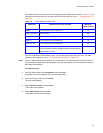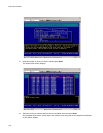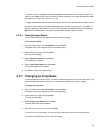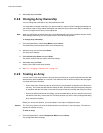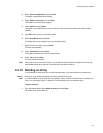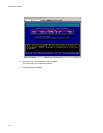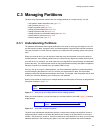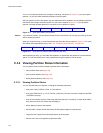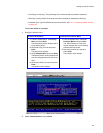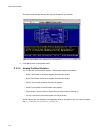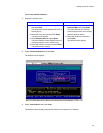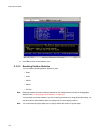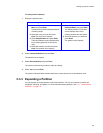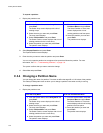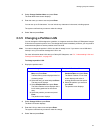
Galaxy 65 User Guide
134
You can only expand a partition into contiguous, following, free space. In Figure 3–2, you can expand
partition 1 or you can create additional partitions in the free space.
After you partition all of the free space, you can expand the size of a partition only by deleting a partition
that follows (has a higher number than) the one you want to expand. In Figure 3–3, you can delete
partition 3 and then expand partition 2 to use some or all of partition 3’s space.
Figure 3–3
Array after creating five partitions
Caution If you delete a partition, you also delete all data stored in the partition. Be sure that you back up all data
before deleting a partition.
When you expand an array, you add free space at the end of the array as shown in Figure 3–4. For more
information about expanding an array, see C.2.6, ”Expanding Array Capacity”, on page 126.
Figure 3–4
Array with five partitions after expanding the array
After expanding an array, you can either add a partition or expand the last partition to use the new free
space. You can also delete one or more partitions and expand a partition into the space.
C.3.2 Viewing Partition Status Information
You can perform three functions related to partition status information:
• View partition status (see page 134)
• View partition statistics (see page 136)
• Reset partition statistics (see page 138)
C.3.2.1 Viewing Partition Status
You can view the status of a partition, including the following information:
• Array state: Online, Offline, Critical, or Fault-tolerant.
• Array type: RAID level (0, 3, 4, 5, 50, Volume, or Mirrored). The term “mirrored” is used for both RAID
1 and RAID 10 arrays.
• Array drives: Number of drives in the array when fault-tolerant. For example, if a three-drive RAID 5
array loses one drive, the number will still display 3.
• Name: Name you give to the partition.
• Serial number: Unique number the Galaxy 65 Subsystem assigns to each partition.
• Target ID:LUN: Target ID and LUN presented to the host system.
• Partition size: Size of the partition (expressed in MB).
Partition 1 Partition 2 Partition 3 Partition 4 Partition 5
Partition 1 Partition 2 Partition 3 Partition 4 Partition 5 Free space




